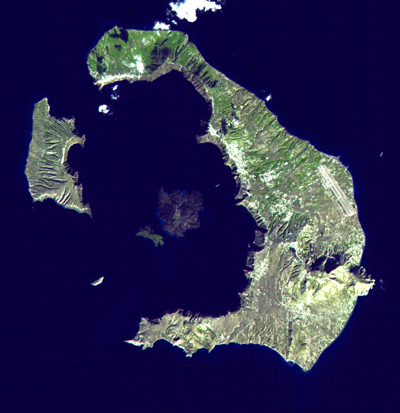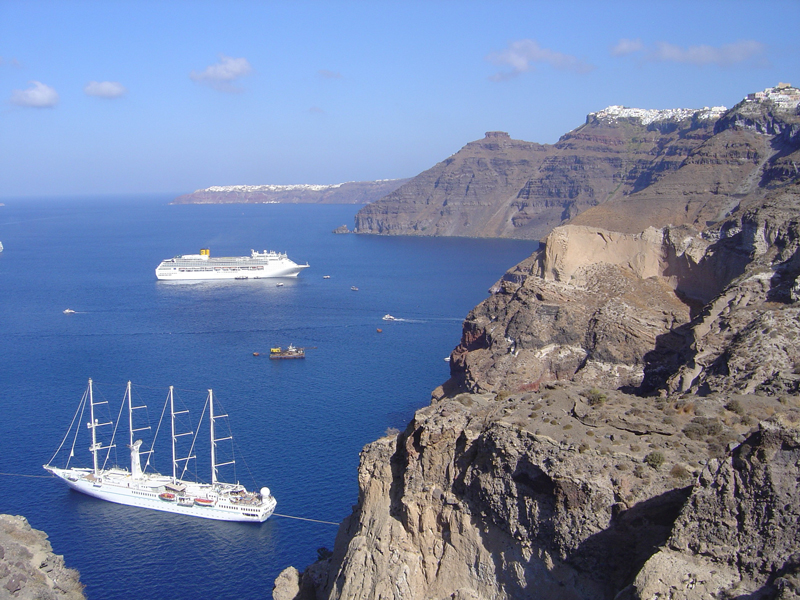
For thousands of years, the Greek volcano Santorini has blasted, bubbled, and burned in the Aegean Sea. Now scientists suspect that rising and falling sea levels are the cause of the volcano’s fiery bursts. The findings reveal a novel connection between the planet’s molten innards and its climate.
Sea levels retreat when the planet grows large ice sheets and glaciers; ice ages have much lower sea levels than interglacial periods.
Researchers from the United Kingdom and Sweden found that these lower sea levels tend to disrupt Santorini’s volcanic slumber. During the past 360,000 years, the volcano, officially known as Thira and historically known as Thera, has erupted more than 200 times. All but three of those eruptions happened during or just following periods of low sea levels.
Since most volcanos on Earth sit within or near oceans, Santorini’s tale could apply to other volcanos around the world.
Santorini’s Cliffs

Santorini has had a violent past—explosive eruptions have shattered the volcano into slivers of islands.
The most recent explosive eruption, in the 1600s BCE, sent 100 cubic kilometers of material into the air, 4 times that of the 1883 eruption of Krakatoa. The volcano’s caldera collapsed into the sea and flooded, leaving an 11-kilometer-wide crater. (The cataclysm may have inspired Plato’s story of Atlantis, too.)
Over the past 50 years, geologists discovered mounting evidence that the comings and goings of ice sheets revved up volcanos in Iceland, the western United States, France, Germany, and Chile. The ice sheets bore down on Earth’s crust, but when they melted away, the crust decompressed and fractured. Magma shot up the cracks and fueled eruptions.
Sea level, the new paper argues, has the same effect on Earth’s crust. “The only thing that’s different is in one case you have ice, and in the other case you have water,” said Earth scientist Chris Satow from Oxford Brookes University, who led the research.
But finding evidence of sea level’s effect on volcanos has been much harder—until now. A quirk of Santorini’s landscape gave scientists a unique chance to connect the pieces.
Millions of tourists flock to the volcano’s cliffs overlooking the turquoise bay annually, and Satow and his team did the same—but to sample layers of volcanic ash. Eruptions leave unique chemical fingerprints of iron, silica, potassium, sodium, and other elements buried in ash layers. “Not many other volcanoes have got this amazing record on display for us to see and investigate,” said Satow.
The researchers measured the chemical fingerprints of each ash layer and matched them with layers in marine sediments. Crucially, the marine sediments also contained records of sea level rise and fall over time.
Satow and eight others published the research in the journal Nature Geoscience today.
Stifled By the Sea

The results could explain recent behavior at Santorini. The volcano threatened to erupt as recently as 2011–2012 when new magma flooded the volcano’s shallow magma chamber. “The fact that an eruption did not happen may be due to the sea levels being high,” Satow said.
But major eruptions can still happen; Santorini is one of the world’s Decade Volcanoes, sites identified in light of their history of large, destructive eruptions and proximity to densely populated areas. “The large volumes of magma involved [in explosive eruptions] could by themselves create the required fractures in the crust, even without the help of low sea levels,” Satow said. The massive event that took place in the 1600s BCE, nicknamed the Minoan eruption after the region’s distinct Bronze Age civilization, was one of three eruptions that blew during periods of high sea levels.
Climate change is melting ice sheets and boosting sea levels, but it’s too early to know how that could affect volcanic activity. A study on the volcanic Caribbean island of Montserrat, for instance, proposed that rapid sea level rise could amp up volcanic activity, the opposite effect seen at Santorini.
“We need more of these detailed and comprehensive studies to get a complete picture,” said Julie Belo, a scientist at the GEOMAR Helmholtz Centre for Ocean Research Kiel who did not participate in the work.
Next, Satow hopes to investigate greenhouse gas emissions from volcanos. “It would be really interesting to know if the amount of carbon dioxide that volcanoes worldwide produce is also related to sea level change,” Satow said.
—Jenessa Duncombe (@jrdscience), Staff Writer
Citation:
Duncombe, J. (2021), In a twist, a Greek volcano ruled by the sea, Eos, 102, https://doi.org/10.1029/2021EO161555. Published on 02 August 2021.
Text © 2021. AGU. CC BY-NC-ND 3.0
Except where otherwise noted, images are subject to copyright. Any reuse without express permission from the copyright owner is prohibited.

